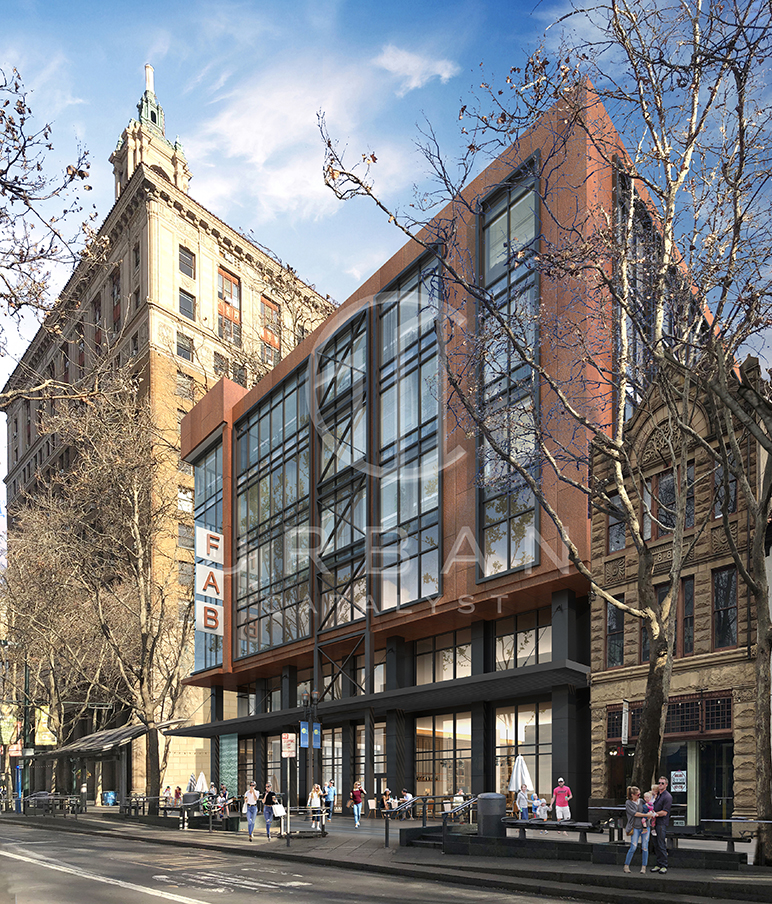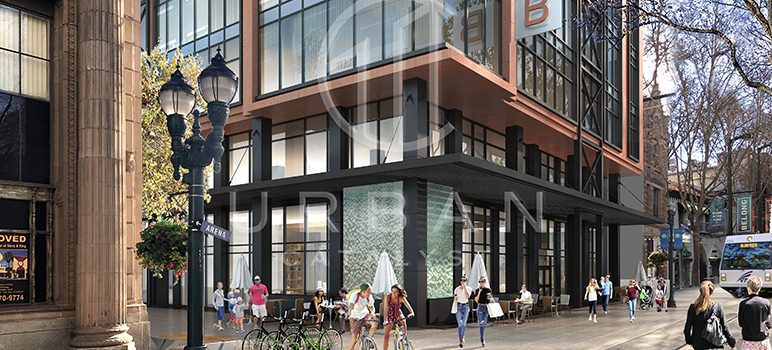A developer has submitted plans to tear down the former site of Lido’s Nightclub in downtown San Jose. In a preliminary proposal given to the city’s planning department last week, San Jose-based developer Urban Catalyst said it wants to redevelop the building on 30 S. First St.—known as the Lido Building—into a 76,000-square-foot mixed-use project comprising office and ground-floor retail space.
The plans also include the historic Knox Goodrich Building next door. While preserving much of the building’s historical structure, the developer wants to make it building part of the lobby of the new building.

A rendering of the proposed project.
Josh Burroughs, Urban Catalyst’s COO and SVP of development, told San Jose Inside he doesn’t yet know what tenants will occupy the building. But the company is hoping to attract small and medium-sized businesses, he said.
“We really want to be a catcher’s mitt for businesses that might be pushed out from some of the larger projects downtown,” he said.
Urban Catalyst hopes to start construction by April 2021.
The development, called Fountain Alley, is being followed closely because of its ties to a new federal tax program. If approved, the development would be San Jose’s first “opportunity zone” project. Opportunity zones are regions around the country that offer tax breaks to investors who put money into those areas.
Real estate investors and developers have been particularly excited about the opportunity zone program, which was part of the tax bill signed into law last year by President Donald Trump. The tax break applies to investors who put capital gains—the profit made from the sale of stock or property—into funds that support development.
The idea is to encourage development in places that haven’t historically seen it, although there have been some concerns it may speed up gentrification.
Burroughs said that proposing a project in an opportunity zone makes finding money to build the project much easier because there’s an added incentive for investors.
“It gives us a whole new group of potential investors to invest in real estate,” he said. “It’s a whole new tranche of money.”
Downtown is beginning to see a host of new developments, as developers hope to take advantage of Google’s incoming campus and the extension of BART to the area. “We want to expedite the vision for downtown San Jose that’s already in place,” Burroughs said.


What about the meth heads currently in Fountain Alley ? Are they invited as well.
Donald Trump, Gentrification, OMG what’s this slum coming to?
“gentrification”: the buying and renovation of houses and stores in deteriorated urban neighborhoods by upper- or middle-income families or individuals, raising property values but often displacing low-income families and small businesses.
WORD ORIGIN
First coined in the 1960s by sociologist Ruth Glass, the term gentrification has proven to be important in the scholarship and popular discussion of urban development. In her 1964 book London: Aspects of Change , Glass uses gentrification to describe a shift she observed in many London neighborhoods in which middle-class people began moving into traditionally working-class areas. She noted that once started, gentrification can progress “rapidly until all or most of the original working class occupiers are displaced, and the whole social character of the district is changed.”
Note: “gentrification” appears to an instance of “progressive ventriloquism” whereby, “intellectuals” (e.g. “sociologists”) express what “low-income families and small businesses” ought to think about productive people making improvements to their neighborhood though investment of work and capital.
The intellectuals impose their class warfare prejudices to oppose the expansion of civilization.